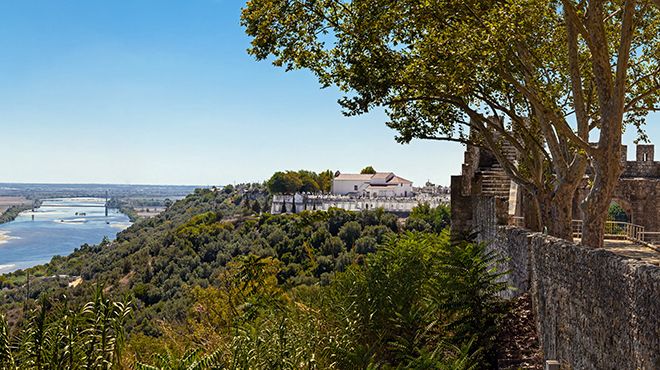Santarém

Santarém
Towns and Villages
The River Tagus and the fertile meadowland surrounding the plateau on which Santarém stands have been important factors in the settlement of the area since remote times. The Roman name for Santarém was Scalabis, and they were also responsible for its urban layout and for making it one of the most important cities in Lusitania. From the 8th century onwards, the Moorish domination strengthened the city's strategic and military role and its name was altered to Chanterein, the immediate predecessor of the present-day Santarém. In 1147, D. Afonso Henriques conquered the city with great expertise and definitively marked the advance of the Christian Reconquest by conquering Lisbon in the same year.
Santarém was to become one of the favourite cities of the Portuguese monarchs as early as the first dynasty. During the Middle Ages, the intense trading activity that took place here, coupled with the establishment of the nobility in the city, helped Santarém to reach its period of great social and economic development, as can be seen in its various monuments and buildings. During this period of great artistic and cultural opulence, Santarém was a royal residence and the capital of the kingdom of Portugal (1325-57), and, until the 15th century, it was frequently the meeting place of the early Portuguese parliament (known as the Cortes).
In 1491, Prince Afonso, the son of D. João II and the heir to the throne, died accidentally in the Ribeira de Santarém. After this episode, the royal family began to keep away from the city to some extent and there was a sharp decline in investment in this area, although from time to time it did figure in Portuguese History once again. Pedro Álvares Cabral, who discovered Brazil in 1500, lived in Santarém for many years.
One of the best ways of discovering Santarém is through its cultural and artistic heritage. You can also visit the city during the events that serve to highlight some of the region's best features. In June, there is the National Agricultural Fair, where agricultural produce and instruments are displayed and a cattle market is held. You also have the chance to see a bullfight if you're a fan of this particular sport.
October is the month when the National Gastronomy Festival is held, the main gastronomic fair in Portugal. These events are complemented by exhibitions of handicraft and folklore from all over the country. If possible, make sure to take the opportunity to watch the traditional dance of the Ribatejo region: the Fandango. This involves at least two men simulating a fight and symbolises the special skills of the cowherds who work in the nearby meadows.
Santarém was to become one of the favourite cities of the Portuguese monarchs as early as the first dynasty. During the Middle Ages, the intense trading activity that took place here, coupled with the establishment of the nobility in the city, helped Santarém to reach its period of great social and economic development, as can be seen in its various monuments and buildings. During this period of great artistic and cultural opulence, Santarém was a royal residence and the capital of the kingdom of Portugal (1325-57), and, until the 15th century, it was frequently the meeting place of the early Portuguese parliament (known as the Cortes).
In 1491, Prince Afonso, the son of D. João II and the heir to the throne, died accidentally in the Ribeira de Santarém. After this episode, the royal family began to keep away from the city to some extent and there was a sharp decline in investment in this area, although from time to time it did figure in Portuguese History once again. Pedro Álvares Cabral, who discovered Brazil in 1500, lived in Santarém for many years.
One of the best ways of discovering Santarém is through its cultural and artistic heritage. You can also visit the city during the events that serve to highlight some of the region's best features. In June, there is the National Agricultural Fair, where agricultural produce and instruments are displayed and a cattle market is held. You also have the chance to see a bullfight if you're a fan of this particular sport.
October is the month when the National Gastronomy Festival is held, the main gastronomic fair in Portugal. These events are complemented by exhibitions of handicraft and folklore from all over the country. If possible, make sure to take the opportunity to watch the traditional dance of the Ribatejo region: the Fandango. This involves at least two men simulating a fight and symbolises the special skills of the cowherds who work in the nearby meadows.




 Explore
Explore 
 Remember and Share
Remember and Share 


